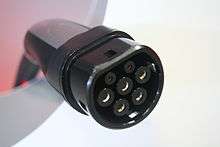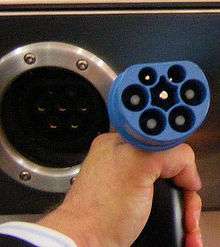Type 2 connector





The IEC 62196 Type 2 connector (commonly referred to as Mennekes) is used for charging electric cars within Europe. The connector is circular in shape, with a flattened top edge and originally specified for charging battery electric vehicles at 3–70 kilowatts. Electric power is provided as single-phase or three-phase alternating current (AC), or direct current (DC).
Cars are fitted with a standardised male vehicle inlet, whilst charging station are fitted with a female outlet, either directly on the outside of the charging station, or via a flexible cable with permanently attached connector on the end. A charging station with a permanently fixed cable can be attached directly into the vehicle inlet, similar to using a petrol pump and when no fixed cable is available, a separate male-to-female cable is used to hook up the vehicle either using the charging station, or from a traditional IEC 60309-2 industrial connector.
The Type 2 connector system was originally proposed by Mennekes in 2009 leading to the colloquial name of Mennekes. The system was later tested and standardised by the German Association of the Automotive Industry (VDA) as VDE-AR-E 2623-2-2, and subsequently recommended by the European Automobile Manufacturers Association (ACEA) in 2011. As of 2015, Type 2 is intended to replace the previous vehicle connectors used for AC charging within the European electric vehicle network, displacing both SAE J1772 and EV Plug Alliance Types 3A and 3C. For DC charging, the Combo 2 socket (Type 2 supplemented with 2 DC pins) shall become standard in cars, replacing Type 4 CHAdeMO. The transition period is scheduled to last until 2019.
Pins
The connectors contain seven contact places: two small and five larger. The top row consists of two small contacts for signalling, the middle row contains three pins, the centre pin is used for Earthing, while the outer two pins used for the power supply, optionally in conjunction with the two pins on the bottom row which are also for power supply. Three pins are always used for the same purposes:
- Proximity pilot (PP): pre-insertion signalling
- Control pilot (CP): post-insertion signalling
- Protective earth (PE): full-current protective earthing system—6-millimetre (0.24 in) diameter[1]
The allocation of the four normal power supply pins vary depending on the mode of operation. They are allocated as one of:
- Neutral (N) and line (L1): single-phase AC
- Neutral (N) and line phases (L1, L2, and L3): three-phase AC
- Neutral (N) and line (L1); negative (−), and positive (+): combined single-phase AC and low-current DC
- Negative (−) and positive (+): low-current DC
- Negative (−, −) and positive (+, +): mid-current DC
Communication takes place over the signalling pins between the charger, cable, and vehicle to ensure that the lowest common denominator of voltage and current is selected.
DC charging
Some vehicle inlets may contain the extra connections to allow the Combo Coupler DC-only charger to be inserted.[2]
See also
- Chademo, for rapid charging.
References
- ↑ Oestreicher, Ralf; Daimler (30 July 2010). "AC/DC vehicle inlet options: As proposed by German Initiative Charging Interface" (presentation slide image). Plug-in 2010. Retrieved 7 April 2016.
Reuse of 6mm earth pin of AC connector allows non isolated DC charging or use of one isolation transformer for several vehicles at up to 250A DC
- ↑ European Automobile Manufacturers Association (2 March 2011). "ACEA position and recommendations for the standardization of the charging of electrically chargeable vehicles". Brussels. Retrieved 14 June 2014.